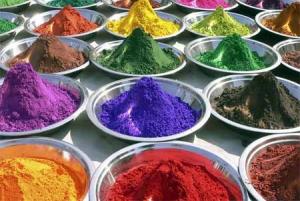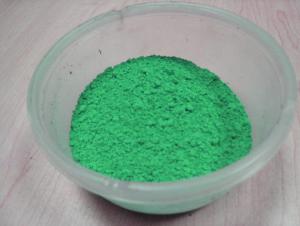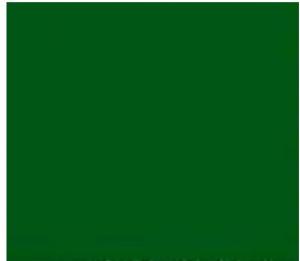Phthalocyanine Green G, C.I.P.G.7
- Loading Port:
- Qingdao Port
- Payment Terms:
- TT or LC
- Min Order Qty:
- 1 Metric Ton m.t.
- Supply Capability:
- 7,500MT/Year m.t./month
OKorder Service Pledge
OKorder Financial Service
You Might Also Like
Product Details Of Phthalocyanine Green L8710 :
It is deep green posder with bright color and high coloring ability.
It can't dissolve in water and ordinary solvent.
It's olive green in concentrated sulphuric acid and turns to green sediment after diluted.
It has good sunning-resistance and heatresistance which belong to chorocopper phthalocyanine fade-less color.
TDS of Phthalocyanine Green | |||||
Chemical Structure | CuPc Halide | ||||
Color Index No. | PG 7/74260 | ||||
Application | Paint | ||||
Physical Form | powder | ||||
| |||||
Test Items | Index | Test Method | |||
Relative Tinting Strength | 100 +_5% | DIN55986 | |||
ΔE,ΔL,Δa,Δb | ≤1,+1,+1,+1 |
| |||
| |||||
Items | Index | Test Method | |||
PH | 6.5~8 | DIN ISO 787-9 | |||
Density 20℃ g/cm3 | 2.1 | DIN ISO 787-10 | |||
BET m2/g | 61 | DIN 66131 | |||
Oil absorption g/100g | 32~42 | DIN ISO 787-5 | |||
105℃ Volatile Matter | ≤1.0% | DIN ISO 787-2 | |||
Water Solubles | ≤1.5% | DIN ISO 787-13 | |||
Residue on Sieve 100 mesh | ≤5% | DIN 53195 | |||
| |||||
Solvent Resistance | Index | Test Method | |||
Water | 5 | DIN ISO 105-A03 | |||
White Spirit | 4~5 | DIN ISO 105-A03 | |||
Ethanol | 4~5 | DIN ISO 105-A03 | |||
Acetone | 4~ 5 | DIN ISO 105-A03 | |||
Di methylbenzene | 4~5 | DIN ISO 105-A03 | |||
| |||||
Tolerance | Index | Test Method | |||
Light Fastness | 8 | DIN ISO 105-A03 | |||
Weather Resistance | 5 | DIN ISO 105-A03 | |||
Acid Resistance | 5 | DIN ISO 105-A03 | |||
Alkali Resistance | 5 | DIN ISO 105-A03 | |||
Hot Resistance | 230℃ |
| |||
Suggest Using of Phthalocyanine Green :
It is used for coloring of paints. printing ink, varinished cloth and things of culture & education.
Package Of Phthalocyanine Green :
25 kg / bag ,or as your requirement .



- Q: What pigments are used in photosynthesis?
- Chlorophyll(green) is the primary pigment used in photosynthesis. Besides chlorophyll, plants also use pigments such as carotenes(orange) and xanthophylls(yellow).
- Q: I always hear about pigments from MAC and Loreal, etc. and I am confused about what exactly they are.So can someone please THOROUGHLY explain what they are and what they can be used for?
- Pigment okorder Pigments can be used for many different cosmetic purposes. eyeshadow blushes added to a clear gloss you make a brand new lip gloss added to clear nail polish base. a hilight color, added to body spray for shimmer added to gel for a tinted gel the list goes on and on. i hope this helps!
- Q: i would like to now so i could put it in a marker thanks..
- Isn't all ink pigmented? A quick search for make your own ink turned up many recipes. Here is one: Basic Permanent Black Ink: 1 egg yolk 1 tsp gum arabic 1/2 cup honey 1/2 tsp lamp black (buy in a tube or make by holding a plate over a lit candle) Mix egg yolk, gum arabic and honey in a small bowl.
- Q: What is the difference between a pigmented eyeshadow and a non - pigmented one?
- A pigmented eyeshadow means that it comes out on your eyes the color it is in the tray or palette for example you buy a black eyeshadow and when you swatch it or apply it to your eyes it looks dark gray or just completely different from how it appears to be
- Q: How do you use pigments?
- technically, pigment is a coloured mineral of a few type it relatively is floor as fantastic as available. (i.e., cobalt is blue, iron produces reds, etc.) Pigment is a similar whether it fairly is in cosmetics, ceramics, or in paint. in spite of the undeniable fact that, cutting-ingredient chemical ingredients can even have the end results of coloring the ingredients of cosmetics, yet that would lead them to a colorant, no longer a pigment.
- Q: I have been looking over the internet and have yet to find the details I need. Such as the function and development of Pigments.
- any of a group of compounds that are intensely coloured and are used to colour other materials.Pigments are insoluble and are applied not as solutions but as finely ground solid particles mixed with a liquid. In general, the same pigments are employed in oil- and water-based paints, printing inks, and plastics. Pigments may be organic (i.e., contain carbon) or inorganic. …
- Q: i bought the new neon pro pigments from mac , well 5 out of the six and i also bought 'basic red'i want to use these as eye shadows but i dont know howi also bought mac mixing medium for face and body but lol , i dont know how to use any of this stuffwhat can i do to use this stuff i mean will it turn out like regular eyeshadow if i use it right? will there be a shine to it? it will reduce fall out? should i put the mixing medium on my eye first , then let dry?do i need to possibly press the pigments in a pot with some kind of eye shadow liquid?i also bought the mascara mixing medium but want to know exactly what to do with thatand also , can i mix any of the pigments with lipgloss?http://cn1.kaboodle /hi/img/2/0/0/119/a/AAAAAlrx1LUAAAAAARmgiA.jpg
- Mac Pro Pigments
- Q: the absorption spectrum and the range of light reflected by each
- A okorder /... gives the spectra (Action and Absorption)
- Q: i got some pigments off of ebay and i received two of them but they have a funny smell to them? are they supose to?
- *~...Welcome...It won't Be long Til U substitute into A MAC Addict. Hehe. nicely unfastened Eyeshadows Can Get Very Messy, So I recommend employing A Primer Or An Eyeshadow Base once you employ The Pigments. The Pigments Will final longer And the colour would be greater vivid. =) have faith Me, as quickly as you have tried MAC you will like it.... additionally, in case you like the Pigments, could i want to recommend splendor From the Earth...they have tremendous shade possibilities it incredibly is greater much less high priced.... get excitement from!
Send your message to us
Phthalocyanine Green G, C.I.P.G.7
- Loading Port:
- Qingdao Port
- Payment Terms:
- TT or LC
- Min Order Qty:
- 1 Metric Ton m.t.
- Supply Capability:
- 7,500MT/Year m.t./month
OKorder Service Pledge
OKorder Financial Service
Similar products
Hot products
Hot Searches
Related keywords
























